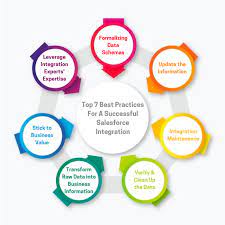Salesforce is a leading Customer Relationship Management (CRM) platform that has helped millions of users manage data, streamline communication between customers and businesses, empower sales and marketing, and much more. Salesforce is a prominent CRM service provider which has a significant impact on several businesses and industries. However, having CRM is not enough for large-scale companies.
You must integrate with other platforms to enhance your business or application. The process of Salesforce integration can be daunting and complex; however, it is worth every penny of it. It will expand your horizons and unlock endless business possibilities. Most of all, it will help you streamline the CRM process and enhance communication. Salesforce Integration is a winning formula, but understanding the Salesforce Integration best practices is the cherry on top. Moreover, following Salesforce integration best practices ensures you are on the right path to successful communication.
First, let’s delve into why you require it and the best practices you must have to elevate your organization.
Why Do You Need Salesforce Integration Best Practices?
Salesforce Integration facilities for migrating two or more applications, such as enterprise resource planning, payment gateways, management software, and more. Salesforce integration signifies integrating the CRM platform with other platforms. For example, Salesforce into Gmail will be Salesforce Gmail integration.
It is crucial because it unifies experience and gives comprehensive opportunities, which help businesses boost productivity and improve client engagement. In other words, Salesforce integration is a process that merges with other platforms to understand every customer clearly. For instance, you will have clarity and detailed insights into different segments, such as sales, marketing, services, and commerce.
Now, let’s understand the reasons behind opting for Salesforce integration. Also, it will help you understand the purpose of best practices for your Salesforce integration.
- Enhanced performance
By following best practices for Salesforce integration, you can improve your business performance, which leads to a boost in productivity. Also, implementing best practices like data syncing or optimizing crucial information with the help of integration can enhance your business. Moreover, it will help you connect methods and minimize processing time, which will ensure your performance will not be affected despite volume growth.
- Optimize Your Workflow
The Salesforce integration best practices can help you to optimize and streamline your workflow. The integration will ease your work with extensive features and functionality, which eventually provide a seamless workflow. In other words, you are reducing your time and efforts, and integration enables you to focus on your complex business processes. As a result, you will be able to give more time to opportunities which will grow your organization.
- Focus on Main Targets
With Salesforce integration best practices, you can concentrate on or achieve the primary targets of your business. Moreover, by integrating Salesforce with another planning platform, you can plan targets which will help your business to boost. In addition, it will enable you to maintain accurate and consistent data, which facilitates efficient business patterns.
- Decrease error
The automation integration process will reduce the chances of errors. As you follow the best practices guide, you will understand what to perform and what not to, which leads to decreased errors. You can enhance your organization’s objectives with fewer errors because of defined planning and targets.
4 Salesforce Integration Best Practices to Follow:
You must adhere to the following best practices to maximize Salesforce integration with third-party applications. Whether you are a small business or a large-scale organization, best practices will upgrade your business workflow in every aspect of your organization. Let’s go through the essentials points of Salesforce integration best practices:
1. Define Your Business Requirements
Before starting to integrate, it is crucial to understand what your business needs. For instance, if you integrate with third-party applications unsuitable for your business, your efforts, money, and time will be wasted. Moreover, you will get no fruitful results, and chances of negative impact will increase.
Hence, getting a clear picture of your business requirements is vital. Find the third-party application which suits your needs, and analyze how to integrate it seamlessly with your Salesforce account
.
2. Update the Information
Another crucial factor which needs to be taken into consideration while integrating is that your data and information are updated. If it is not, again, you will be investing in the wrong resource. As a result, you are unable to have a successful integration of Salesforce with third-party applications.
Additionally, accurate information will create numerous issues, such as wrong data calculation or assigning information incorrectly. Hence, update accurate information before upgrading or integrating your Salesforce into another application.
3. Ensure Security and Compliance
Security is the foremost aspect of any organization, as any vulnerability threat can destroy your entire business. So, while Salesforce integrates with third-party software, you must ensure security and compliance guidelines.
Focus on data security and maintain compliance thoroughly during integration. Implement transmission mechanisms and access controls to protect your crucial business data. Also, you must regularly assess and update security measures that adhere to emerging vulnerabilities and threats.
4. Thoroughly Test and Review
The last best practice for Salesforce integration is testing and reviewing thoroughly. Ensure you require comprehensive testing to identify and adhere to integration issues before developing. Testing includes multiple scenarios, such as deploying testing, data mapping, and more. Determine it and review the testing process thoroughly.
Conclusion
Following and addressing Salesforce integration best practices will help your business grow and expand in the right direction. However, if you are having issues with integration, you can contact Salesforce integration services to streamline your process.
